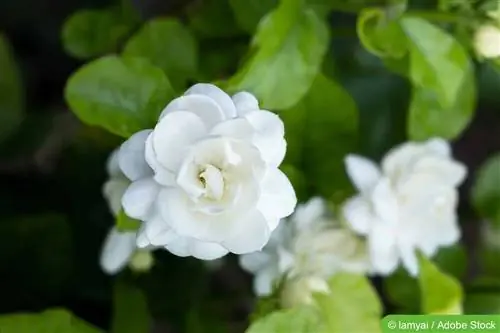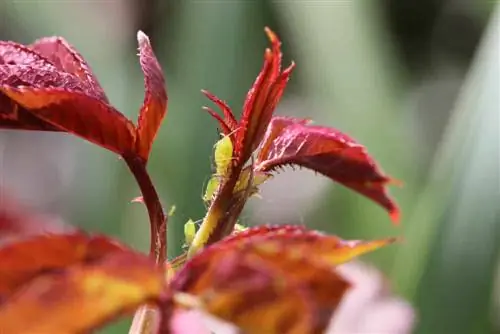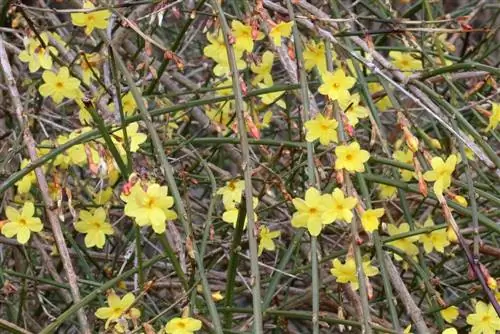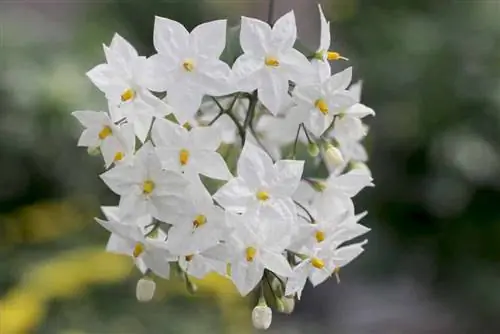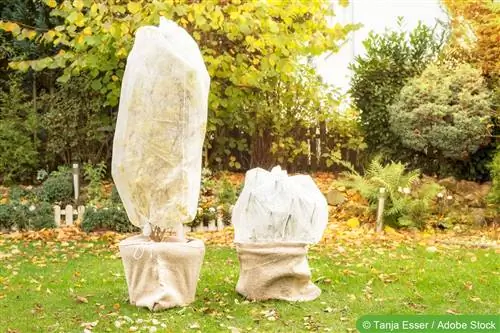- Author admin [email protected].
- Public 2023-12-17 03:39.
- Last modified 2025-01-24 12:45.
The Arabian jasmine differs in its leaves, because they are not pinnate like normal jasmine. Rather, they are rounded and have entire edges. But what is particularly special is its strong, intense scent and the fact that the Jasminum sambac can also be used as a climbing plant. All you have to do is tie it up.
Suitable as a balcony or patio plant
Since Arabian jasmine cannot tolerate frost, it should not spend the winter outdoors. Therefore keeping them in pots is also well suited. In a winter garden it can also be used as a ground cover, as it can grow in bushes but hardly climbs itself. The white six or seven petaled flowers have a strong scent and pamper the senses. The jasmine does not place any great demands on the soil, as simple potting soil for potted plants with a little expanded clay can be used here. It also doesn't have to be watered constantly, although this also depends on the location. This also depends on the location, because the plant must not dry out.
Jasmine is characterized by its long flowering period
The flowering period is from early summer to late autumn, when the first frost can occur. This is also the time when Arabian jasmine is no longer allowed to stand outdoors to overwinter. It can also be cut back for this purpose. It doesn't have to be in a heated room, but it shouldn't be exposed to frost. A dark room is best, so the plant can recover best. In the spring it has to slowly get used to the sun again, and it doesn't have to go straight to its final location. Of course, if it is already clear where this should be, the shoots can then be tied up there.
Warm overwintering ensures lots of flowers
Although Arabian jasmine can overwinter in a cold and dark place, if it is placed in a warm and bright place, it can develop more flowers next year. The plant only needs to be watered as needed over the winter. If it is cool and dark, less watering is required than if it is bright and warm. There is also no fertilization in the cold season. After flowering, you can also cut back, which will result in a larger flower. The Jasminum sambac then continues to grow like a bush. If you want, you can also cut back heavily, but this should only be done as needed.
Delicate yet robust
On the one hand, the Jasminum sambac is sensitive to water and frost, but there is hardly any risk of illness. If you water too much, the roots can rot. This of course leads to the plant dying. Otherwise, even beginners can't really go wrong, because the Jasminum sambac almost always blooms. Of course, this also depends on whether it is regularly supplied with water and fertilizer. During the flowering period, this jasmine has an increased need for fertilizer and therefore this should be done once a week. A long-term fertilizer or complete fertilizer is suitable for this. Dank is a plant with beautiful and strongly scented flowers. And not just in summer, but right into late autumn.
The plant does not tolerate waterlogging
Since the Jasminum sambac does not tolerate waterlogging, the soil must also be well-drained. To be on the safe side, drainage can also be placed in the pots. This will keep the roots moist but not wet, as this would cause the plant to rot. Therefore, the need for water always depends on the location. If it is in the sun, of course it needs to be watered more. Otherwise only moderately, because drought means that the Arabian jasmine does not develop flowers. Because the scent of the flowers is so intense, they are also used to make perfume. Above all, the rich green of the leaves and the white flowers make the Jasminum sambac a real feast for the eyes. Especially since this plant in pots or flowers beautifies any balcony or terrace. Because not everyone has a winter garden where this creates an accent as a ground cover. Little things that should be noted:
- permeable soil so that water can drain away
- blooms from early summer to late autumn
- get it in before the frost
- can overwinter both cool and warm
- cut back after flowering for more flowers
- Hardly climbs, but can be tied up
- fertilize once a week in summer
- Watering only as needed and location
If you pay attention to these things, you will enjoy your Arabian jasmine for more than just one year, because it is a perennial plant. It is still relatively undemanding, which is particularly popular with people who have little time. Without much effort, you can enjoy the flowers and the scent all summer long. This isn't really demanding when it comes to overwintering either, as the jasmine can also overwinter in the living room. This is good for people who have very little space available, because not everyone has a suitable stairwell or basement available.
Few things lead to success
This means that the plant can be placed outdoors in both sunny and shady locations. This is only noticeable in the water requirement, which then has to be taken into account. The only expense is that it has to be fertilized once a week. However, only during the flowering period, after which the plant simply rests. So you can expect abundant flowering again even after winter. Especially if the Jasminum sambac has been pruned well. This makes the plant also suitable for people who are not really that successful with plants. Just get a nice balcony or winter garden without too much work.
What you should know about Arabian jasmine in brief
- Arabian jasmine differs from other types of jasmine in its leaves. They are not pinnate leaves, but round ones with entire edges.
- Jasminum sambac is an upright growing or climbing evergreen shrub.
- The strong scent of the flowers is particularly striking.
- In contrast to other types of jasmine, Arabian jasmine does not grow as quickly.
- It is good as an underplant and ground cover in the winter garden, but also as a potted plant on the balcony and terrace.
- The flowers appear in early summer, then the shrub blooms until late autumn, until the first frosts.
- A scaffolding to which the shoots can be tied up is a good idea.
- Jasminum sambac is used to make perfume. It is also used to flavor tea.
- This jasmine is even used in aromatherapy.
Location
In the summer you can place Arabian jasmine outdoors. He should be slowly acclimated to the sun. The closer it is to one of your favorite places, the more you will enjoy the intoxicating scent. In winter the winter garden is an ideal place to stay. The plant can also overwinter in a cool place, but it should be frost-free.
Planting substrate
Permeable, humus-rich soil with a loam or clay additive is ideal. You can use normal pot plant soil and add some expanded clay. The main thing is that the excess water can drain away easily. Drainage at the bottom of the pot is recommended for the same reason.
Watering and fertilizing
Jasmine sambac copes well with drought. However, it shows this by hanging its shoots and leaves. After watering, they straighten up again. If there is strong heat or direct sunlight, watering must be abundant, otherwise only mediocre. Fertilization is carried out regularly. This stimulates flower formation. Fertilize once a week with a mineral complete fertilizer or appropriate slow-release fertilizer.
Wintering
Frost causes all above-ground parts of the plant to die. If the root ball is well protected and the soil does not freeze, the plant can sprout again from the rootstock in spring.
Cut
If you cut back the Jasminum sambac regularly, it forms dense little bushes with an abundance of flowers. You cut after flowering. If necessary, you can also cut back heavily.
Diseases and pests
Diseases and pests are rare. Too much moisture leads to rotting of the roots and often the death of the plant.

